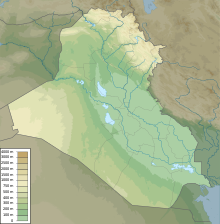Battle of Hanna
| First Battle of Hanna | |||||||
|---|---|---|---|---|---|---|---|
| Part of the Mesopotamian Campaign of World War I | |||||||
 A 1924 British map showing the first attack on Hanna. | |||||||
| |||||||
| Belligerents | |||||||
| |||||||
| Commanders and leaders | |||||||
|
Fenton Aylmer |
| ||||||
| Strength | |||||||
| 10,000 men[citation needed] (remnants of 2 divisions) | 30,000 men[citation needed] | ||||||
| Casualties and losses | |||||||
| 2,741 casualties[1] | 503 casualties[1] | ||||||
Location within Iraq | |||||||
The First Battle of Hanna (
Prelude
After the Ottoman Empire's entry into the First World War, Britain dispatched
On 15 December 1915, Ottoman troops had surrounded the Anglo-Indian force of about 10,000 men at the town of Kut-al-Amara. The British commander
This relief force, commanded by
Battle
After a short bombardment on 20 and 21 January 1916, the 7th Division charged the Ottoman lines. In an advance across 600 yards of flooded no-man's land, the British sustained 2,700 casualties. The well prepared Ottoman positions, notably the well-sited machine gun nests, forced them to abandon the assault and withdraw the relief force to the base of Ali Gharbi.
Aftermath
Medical care was practically nonexistent, and the night after the attack saw freezing temperatures. Many British wounded suffered unnecessarily, and morale plummeted. The besieged garrison in Kut-al-Amara could hear the distant sound of the fighting relief force, and when it remained distant morale there suffered as well.[4]
Despite two more relief attempts, the garrison at Kut-al-Amara was forced to surrender to the Ottoman forces on 29 April 1916 (see Siege of Kut).
Notes
- ^ ISBN 978-0-415-77099-6, p. 93.
- ISBN 978-1-85109-420-2. p. 1047
- ISBN 978-1-85109-420-2. p. 538
- ISBN 978-1-85109-420-2. p. 1048

